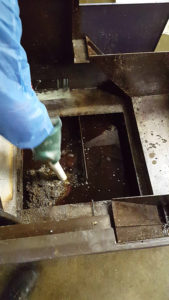Many industrial plants across North America filter their machine tool coolant for reuse. Companies we have spoken with have given us a variety of reason for doing so:
- Reduce Coolant Cost
- Employee Health
- Increase Tool Life
- Reduce Bacteria Growth
- Lower Environmental Impact
The most common reason we hear for companies to filter their coolant is to reduce their overall production expenses. From better tool life to extending coolant life, companies have found ways to save on their bottom line by filtering and reusing coolant. It only takes a little preventive maintenance to be in a position to reuse your coolant. A large portion of in plant maintenance issues are a direct reflection of managements attitude towards preventive maintenance, coolant reuse included. Less preventive maintenance usually leads to more unplanned production slowdown or downtime.
Sump Coolant Preventive Maintenance
Filtering coolant is a preventive maintenance activity that is largely ignored or delayed by some companies for many reasons. A few of the reasons we have heard over the years are:
- It takes too long
- Can’t stop the machine tool
- We are too busy
- It costs too much
- It’s not important
- It’s a dirty nasty job
When there is unplanned slowdown or downtime due to coolant issues, the company can blame the operator, coolant manufacturer or take an honest look at how to use preventive maintenance to stop future problems. A few unplanned production slowdown or downtime problems are:
- Employee health issues related to poorly maintained coolant
- Machine tool pump problems
- Too many parts are scrapped or reworked
- Tools dulling to quickly
- Having to slow the cutting speed
Unplanned down time does not necessarily mean the machine tool stops. It also refers to the machine tool not running at top performance. A good preventive maintenance program can mean higher production levels throughout the company.

Sludge Removal – Pail & Shovel

Sludge Removal – Sump Cleaner
Let’s get back to preventive maintenance of the coolant sump. The most common method for cleaning sumps today involves a pail, shovel, shop-vac and one or two individuals on your staff. Using this method usually creates many hours of machine tool downtime. Companies have told us it takes one or two days to clean out a sump when using a pail, shovel & shop-vac. Not to mention how nasty a job it is to complete. Because it’s a nasty job, many companies put it off as long as possible. When the sump does not get cleaned on regular basis you will tend to see your tools wear faster, higher than normal marring on parts, slower cutting speeds and a greater possibility of unexpected machine tool downtime.
With most every maintenance task that needs to be completed,
the right tool makes the task more efficient. Has your company considered a high-end sump cleaner to clean your coolant sumps? A high-end sump cleaner will be able to sustain a minimum
suction lift of 13 inches of mercury while filtering the sludge from your coolant. The sump cleaner should also allow for dispensing filtered coolant back into the sump or central recycling station. This level of vacuum and dispensing power will move the coolant at 60 to 110 gallons per minute. The coolant & sludge will be vacuumed into the filter at the same time, trap the sludge and allow the cleaner coolant to pass through to a holding tank. This sump cleaner & filter media should be able to remove 85 to 95% of the solids from the coolant.
Filter Media Is Important
The sludge produced by each metalworking operation can be unique. The machine tool, raw material, chip size, and even the machine tool preventive maintenance program, can affect how well the sludge is separated from the coolant. Leaky seal(s) in the machine tool, oil on raw material, or other variables, can affect the sludge that ends up in the sump.
Effective
filtering can be a complex process and the filter basket plays a critical role. The filter basket can come in a variety of sizes, making it sometimes difficult to know what size is right for your application. It might seem like bigger is better. That way, your sump cleaner is prepared for a greater amount of sludge, right? The reality is, it depends. Sump cleaner users must understand their sludge and their operation in order to choose the right filter basket and media. There is no one size fits all approach. When deciding on which filter is the right size, consider these factors:
- How often do you clean your sump?
- What’s your sludge like?
- How often do you empty the filter basket?
- Does it make sense to use different sized baskets?

CECOR 1 cu ft filter

CECOR 2.3 cu ft filter
How often do you clean your sump?
When you do not have the right tool, sump cleaning takes longer and is messier. We have found that customers that use a high-end sump cleaner are able to clean their sumps more often and in much less time. Some of our customer have been able to change an 8-hour sump cleaning task using the wrong tools, into less than 1-hour with the right tools. When you clean your sump more often there is less sludge to filter out and you can use a smaller filter basket. Depending on the weight of your sludge, the smaller filter basket allows one person to both clean the sump and empty the filter basket. When you choose a larger filter baskets you will need a forklift or some other lifting device to remove the filter basket and empty the sludge.
What’s your sludge like?
Depending on your application, your sludge might be muddy and thick, or it might resemble a pile of aluminum chips. Grinding applications typically produce a very muddy, heavy sludge. More common applications like cutting usually don’t result in the same type of sludge. If there is long time between sump cleanings and you get a lot of sludge out of your metalworking fluid, you may need a 2.3 cubic foot filter basket. If you’re only filtering out metal chips, it’s usually easier to use a smaller 1 cubic foot basket.
How often do you empty the filter basket?
Best practice is to clean out your machine tool when the sludge takes up more than 10% of your coolant volume. Speak with your coolant rep to determine the maximum amount of sludge volume you should have in your machine tools coolant tank before it starts affecting your machine tool performance. With the right level of preventive maintenance, cleaning can take 30 minutes and the filter basket can be easily dumped into a chip bin. Even with muddy, heavy sludge, a full 1 cubic foot filter basket might weigh 75 lbs.
If your machine tool operation produces a very high volume of sludge, or you only clean your machine tools once every two years, you should consider a larger filter basket. The larger filter baskets will require:
- Power lift to remove the filter basket
- Larger dumping bin to handle 500lbs or more
Does it make sense to use both?
In some cases, it makes sense to switch between a larger and a smaller filter basket depending on the application, and type or size of machine tool sump you’re working with. Certain sludge may only need a 1 cubic foot filter basket while other applications may require 2.3 cubic foot basket. The high-end sump cleaner should be flexible and offer you the ability to switch between different size filter baskets to meet all your sump cleaning needs. When in doubt, start small. A 1 cubic foot basket is easy to manage and if you find it’s not enough, you can always add the larger basket.



